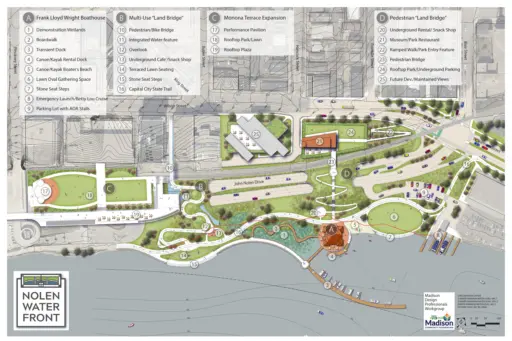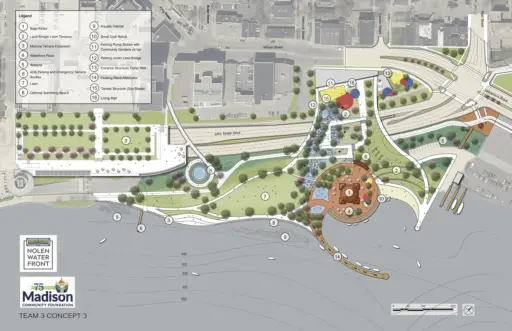When you’re in the business of designing parks or buildings, a frequent piece of advice is this: Start small, but dream big. That’s because you’re usually in it for the long haul—even when you eventually become as famous as Wisconsin-born architect Frank Lloyd Wright.
Case in point: The Monona Terrace Community and Convention Center in Madison opened its doors in 1997, almost 60 years after Wright first sketched its design on paper.
Yet, shorter turnaround times are possible. An idea for the Witte Hall dormitory proposed by four civil engineering students at the University of Wisconsin-Madison in their fall 2012 senior capstone design class, for example, became part of the actual construction plans less than five years later, when dorm renovations began in March 2017.
And Fred Klancnik, an adjunct professor of civil and environmental engineering and regular mentor for the capstone class since 2014, is cautiously optimistic that Witte Hall won’t be the last time for a student-hatched design to materialize in Madison.
 One of the conceptual plans for Law Park started with the spring 2017 proposal by undergraduate student team WAST Engineering (Muhhammad Alqahtani, Miles Tryon-Petith, Erik Silvis, Kyle Williams). Click image to enlarge.
One of the conceptual plans for Law Park started with the spring 2017 proposal by undergraduate student team WAST Engineering (Muhhammad Alqahtani, Miles Tryon-Petith, Erik Silvis, Kyle Williams). Click image to enlarge.
In fact, the next example may even have an intimate connection to Frank Lloyd Wright.
That’s because it involves Law Park, located close to Monona Terrace along John Nolen Drive, and the Lake Monona boathouse that was one of Wright’s first designs at UW-Madison in 1893, when he was a civil engineering student himself.
“Law Park’s revitalization is a project I worked on with two capstone teams in spring 2017 as part of our larger vision for the Nolen Waterfront, which includes building Wright’s boathouse,” Klancnik says. “We started small, but the idea has gained traction with key stakeholders at the city, county and state level. While it’s too early to say when exactly it may be executed, the momentum is definitely there.”
Today’s vision for the Nolen Waterfront is inspired by a stunning master plan for Madison that landscape architect John Nolen prepared in 1909. Since he believed the city had one of the greatest waterfronts in the world, he proposed a signature park connecting the downtown area to Lake Monona. However, his design was never realized and today’s Law Park is a small sliver of land dominated by a six-lane roadway and rail corridor.
Signature parks that started with big dreams similar to Nolen’s and eventually came to fruition include Chicago’s Millennium Park and The Presidio’s Crissy Field in San Francisco, both widely considered a perfect embodiment of each city’s character and brand.
In Madison, Klancnik and others are keeping some of the capstone students’ ideas alive in ongoing conversations about the future of the Nolen Waterfront.
 A second conceptual plan for Law Park grew out of the spring 2017 proposal by undergraduate student team Madtown Engineers (Sam Acker, Rodey Batiza, Daniel Graf, Helen John, Nyaveh Keili). Click image to enlarge.
A second conceptual plan for Law Park grew out of the spring 2017 proposal by undergraduate student team Madtown Engineers (Sam Acker, Rodey Batiza, Daniel Graf, Helen John, Nyaveh Keili). Click image to enlarge.
Key partners in those conversations are the Madison Design Professionals Workgroup, a group of architects, engineers (including Klancnik) and other experts who have worked pro bono on Law Park’s transformation since 2012; Downtown Madison Inc., a nonprofit organization devoted to broader downtown revitalization efforts; the Clean Lakes Alliance , an environmental nonprofit organization for the Madison area’s Yahara Lakes; and the Madison Community Foundation, a charitable organization that has managed endowed funds for the benefit of the community for 75 years.
Also participating in these conversations are three May 2017 civil engineering graduates—Rodey Batiza, Helen John and Miles Tryon-Petith—who have been continuing their capstone projects as members of conceptual planning teams convened by the Madison Design Professionals Workgroup.
Beyond conversations, evidence of momentum toward realizing Nolen’s vision includes a recently approved $500,000 City of Madison budget for continued Law Park design efforts and a supportive audience of more than 200 (including several potential private and public sponsors) at a September 2017 event hosted by Downtown Madison Inc.
That event included presentations of the most recent design concepts and explicit kudos for the capstone students’ contributions.
“I cannot over-emphasize the help we received from UW-Madison’s Department of Civil and Environmental Engineering,” said Dave Mollenhoff, a local historian, book author and member of the Madison Design Professionals Workgroup. “I wish I had the time to tell you how they drilled down to the details of this project to produce reports that would cost thousands of dollars from consultants. This, friends, is a brilliant example of what we call the Wisconsin Idea.”